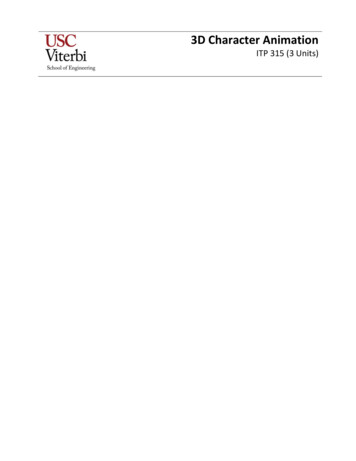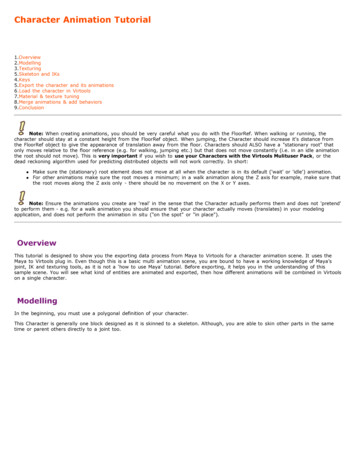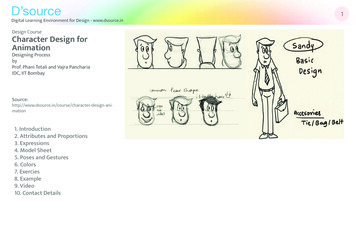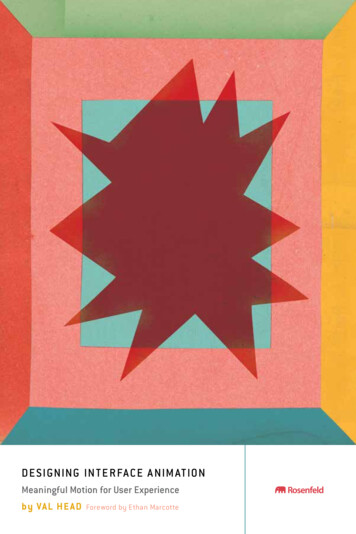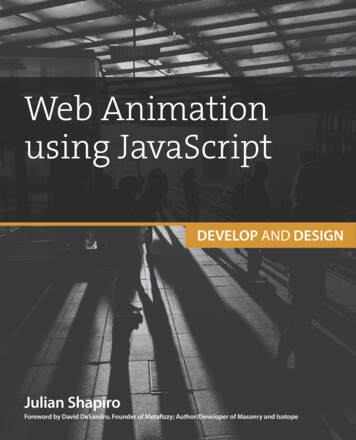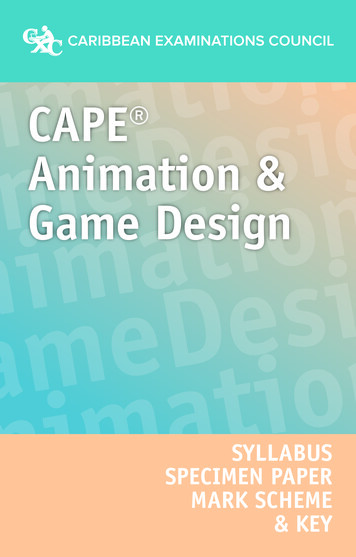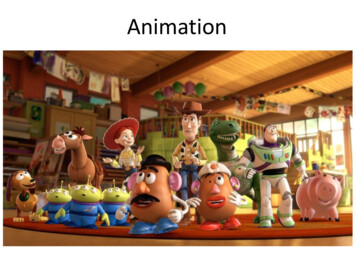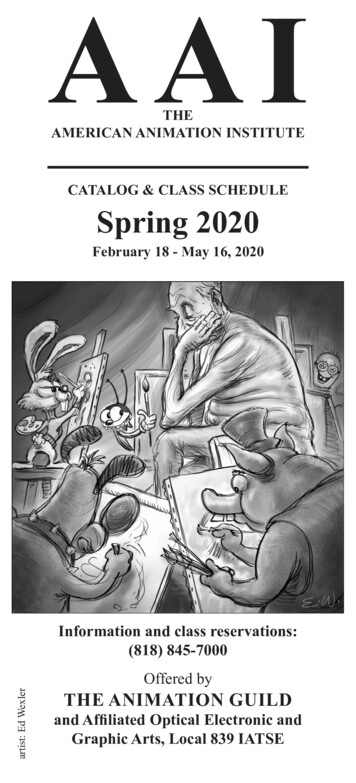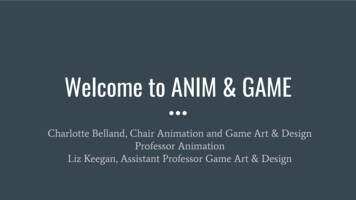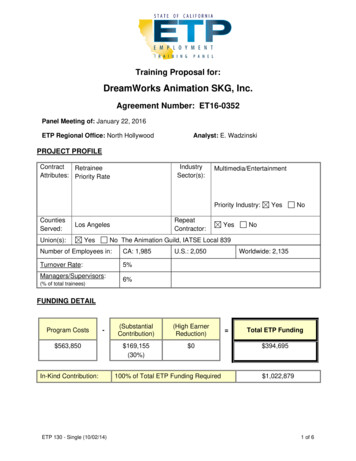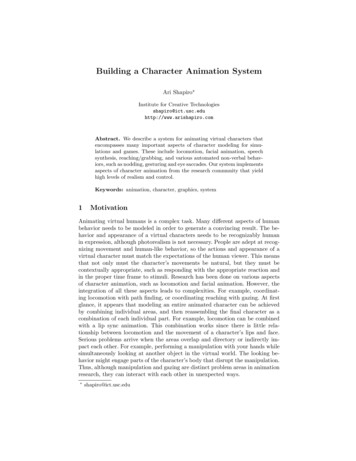
Transcription
Building a Character Animation SystemAri Shapiro Institute for Creative ro.comAbstract. We describe a system for animating virtual characters thatencompasses many important aspects of character modeling for simulations and games. These include locomotion, facial animation, speechsynthesis, reaching/grabbing, and various automated non-verbal behaviors, such as nodding, gesturing and eye saccades. Our system implementsaspects of character animation from the research community that yieldhigh levels of realism and control.Keywords: animation, character, graphics, system1MotivationAnimating virtual humans is a complex task. Many different aspects of humanbehavior needs to be modeled in order to generate a convincing result. The behavior and appearance of a virtual characters needs to be recognizably humanin expression, although photorealism is not necessary. People are adept at recognizing movement and human-like behavior, so the actions and appearance of avirtual character must match the expectations of the human viewer. This meansthat not only must the character’s movements be natural, but they must becontextually appropriate, such as responding with the appropriate reaction andin the proper time frame to stimuli. Research has been done on various aspectsof character animation, such as locomotion and facial animation. However, theintegration of all these aspects leads to complexities. For example, coordinating locomotion with path finding, or coordinating reaching with gazing. At firstglance, it appears that modeling an entire animated character can be achievedby combining individual areas, and then reassembling the final character as acombination of each individual part. For example, locomotion can be combinedwith a lip sync animation. This combination works since there is little relationship between locomotion and the movement of a character’s lips and face.Serious problems arrive when the areas overlap and directory or indirectly impact each other. For example, performing a manipulation with your hands whilesimultaneously looking at another object in the virtual world. The looking behavior might engage parts of the character’s body that disrupt the manipulation.Thus, although manipulation and gazing are distinct problem areas in animationresearch, they can interact with each other in unexpected ways. shapiro@ict.usc.edu
21.1Ari ShapiroGoalsWe aim to synthesize a highly realistic, interactive character, which will likely require high-quality and possibly expensive methods. Many game engines providerobust solutions to many real time simulation problems such as mesh rendering,lighting, particle effects and so forth. However, game engines generally do nothandle complex character animation. They often provide a general framework forreplaying animations on a hierarchical skeleton, as well as a providing mechanismfor blending between animations or looping an animation. However, the intricateand specific motion commonly associated with humans must be constructed bythe game engine programmer and designer. One of the goals of this project is todevelop a character animation system allows the realization of common behaviorsthat are used in real time games and simulations. These behaviors include: synthesizing speech, responding to speech, moving, touching, grabbing, gesturing,gazing, breathing, emotional expression and other non-verbal behavior.The system is not intended to be a framework for the development of character animation via a well-defined interface or with pluggable animation blocks.Such well-defined interfaces are effective for well-defined and understood problems. However, animating a virtual character to a high level of realism has anumber of complexities that are not well understood, and thus don’t benefitgreatly from such simple architectures. Such designs can either under specifythe interface, leaving too much work to the game designers and programmers,or overly simplifying the system, restricting it’s capabilities.2System SummaryThe animation system [10] is designed around a hierarchical, controller-basedarchitecture [3]. The state of the character is manipulated by series of controllers,with the output of one passed as the input to another. Each controller can eitheroverride, modify or ignore the state of the virtual character. The controllers knowthe state of the character during the last step, as well as the state of the characterduring the evaluation phase. The controller stack, which controls the state dataflow, is listed in Table 2 in the order of execution.
Building a Character Animation d offsetIdle motionLocomotionCommentsGlobal orientation and positionUnderlying idle poseOverrides idle pose during locomotion phases, ignored during idle statesAnimationNon-locomotive animations, can encompass entirebody or just upper body during locomotion.ReachAllows reaching and pointing using armsGrabHand control for touching, grabbing, and picking upobjectsGazeLooking with eyes, head, shoulders and waistBreathingChest and diaphragm control, mostly independentfrom rest of skeleton hierarchyConstraintAllows constraints that may have been violated dueto impact of preceding controllers (i.e. keeping character’s hands on a table while turning to look at another objectEye saccadesFast movements for eyes, blended with results fromgazeBlinkPeriodic blinking controlHeadControls head movements; nods, shakes, tilts,backchannelingFaceDetermines activation for blend shapes or bone activations when using joint-driven faces, excluding eyesGeneral parameters Generic controller for transferring non-skeleton datato the rendering engine, such as blushing, tears, GPUshader values, etc.OverrideAllows overriding of state values. Useful when takingcontrol of character from other input devices, such asthe KinectProblems with Generalization/Specialization HierarchySome controllers can hide the impact of earlier controllers by overriding the statevalues. For example, the face controllers (13) overwrites the face state originallygenerated by the idle motion controller (2). This scheme will work for thesetwo controllers, since the face control can be thought of as a specialization ofthe more generic idle pose. However, the locomotion controller (3) must entirelyreplace the effects of the idle motion controller (2) during a certain behaviors,such as walking. Thus, while the hierarchy implies a generalization-specializationscheme, in practice, many controllers have effects that overlaps, extend or replacethe effects of earlier one. As another example, the gaze controller can engagethe entire spine during a gaze behavior when orienting a character’s entire bodytowards a gaze target. However, this will disrupt an animation of, say, a character
4Ari Shapirowhose hands have been placed on a table by the animation controller (4). Torestore these implicit constraints, the constraint controller (9) is activated toreposition the character’s hands according to the constraints.This controller scheme for managing character state requires many additionalrules to effectively control the entire character. Also, certain controllers, suchas the blink and saccade controllers (10 and 11) can work independently fromthe face (13), thus strict ordering is not necessary. Better models need to bedeveloped for controlling character state that more closely match the interactionof different character behaviors with each other.2.2PlatformsThe system is written almost entirely in C , and has been ported to run onboth Linux, OsX. At the time of this writing, we are in the process of portingto the mobile platforms, Android and iOs. The system is licensed under LGPLand is available for download at: otionWe have implemented and experimented with two different locomotion systems;a semi-procedural system based on [2], and an example-based system.The semi-procedural locomotion algorithm uses two example motions; a forward walk and a strafe (sideways walk). The procedural nature of the algorithmallows the use of inverse kinematics to place the feet at the desired position aswell as control the angle of the foot on uneven terrain. Since only two examplemotions are used algorithm, the motion can be parameterized along two axes,each representing either forward or sideways movement. Turning is controlled bysetting step targets and orienting the body in line with the footsteps.The drawbacks to using such this semi-procedural system is the lack of abilityof the algorithm to allow for differing styles of movement. Because the footplacement is established by using inverse kinematics, the nuances of the legmovement from the animation data are replaced with the results from the IKalgorithm. Thus, many different styles of walking on different characters tend tolook very similar below the character’s waist. In addition, the use of foot stepsmakes the motion appear to be clomping, or hard stepping, as compared withmotion captured or hand-animated motion.The example-based locomotion shown in Figure 2 includes 19 different animations to control forward, turning and lateral movement. This locomotionengine does not use IK, and relies almost entirely on blending the motion data,notwithstanding the offset of the character in world space. The example-basedlocomotion currently uses 5 animations for different speeds of forward movement,5 different animations for turning left at various speeds, 5 animations for turningright at different speeds. The forward movement animations consist of two walking or running cycles, and the turning animations consist of a character turningaround at various speeds; turning in place, turning in a tight circle while walking, turning in a tight circle while running and so forth. The size of the turning
Building a Character Animation System5circle limits the amount that a character can turn while moving at a given velocity. The animations are parameterized in three dimensions; forward velocity,turning angle, and sideways velocity. Thus, it is possible to emulate any numberof foot positions through a combination the various parametric animations. Theparameter space of these dimensions can be modeled using tetrahedrons. Theparameter values are automatically extracted from the example motions, suchas determining the average forward velocity of a motion.We have found that the example-based animation produces a more realisticresult, although this method can be susceptible to foot skating if the motiondata is not consistent.Fig. 1. Visualization of the example-based locomotion. Yellow dots on the red axisindicate moving forward (walking, jogging, running, etc.) Yellow dots along the greenaxis indicate turning motions. Yellow dots along the blue axis represent strafing, orsideways movement.2.4Path FindingThe system uses SteerSuite [8] to handle path finding. The separation of locomotion from path finding allows for the development of each area separately. Forexample, we have connected the SteerSuite path finding to one of three locomotion engines; the semi-procedural and example-based system as described in thesection above, as well as to a simple offset engine that alters the global positionof the character without changing it’s pose. The simple engine is used to test the
6Ari ShapiroFig. 2. Example-based locomotion and path.viability of the path planning engine. The more complex engines produce morerealistic-looking motion.The benefits of separating the two problem areas has a consequence; without knowing the limits of locomotion capabilities, the path planner sometimesrequires movements that are sometimes unrealistically fast, and sometimes visually unappealing. For example, the path planner might decide to suddenly switchdirection to avoid an obstacle faster than the locomotion system can realisticallymove the character, thus causing a discrepancy between the planned path andthe actual path.We noticed that many path planners handle large scale movement, such astraversing long distances are large objects, and very few path planners handleintricate movement in small areas and indoors.2.5Reaching and GrabbingOur system utilizes an example-based approach for reaching. From a standingposition, we use 32 different reaching motions to allow a character to most objectswithin arms-length. Each arm uses 16 example motions from four elevations(high, mid-high, mid-low, low). Motions created for one hand can be mirrored tothe other hand in order to reduce the number of examples needed. We interpolatethe reach examples to generate pseudo-examples [4], as shown in Figure 3. Ourreaching algorithm first finds closest sets of examples, and interpolates and timewarps the motion to produce the final motion. Inverse kinematics is then usedto achieve the exact desired location, similar to [1].Because of this reaching technique is based on examples, a different exampleset is required for each type of reaching motion. For example, a series of reachingtasks performed while sitting requires a different set than the standing reachingset, as in Figure 3. Reaching during walking or running would require anotherexample set. Although it is also possible to overlay the reaching examples onthe upper body while animating the lower body, this will cause a loss of realism,since the body will not preserve its movement dynamics. Currently, this reaching
Building a Character Animation System7system does not handle collisions; it assumes a clear path of movement for thereaching. In addition, the reaching examples are synthesized from the startingposition, to the target, then back to the original position. The ability to reach onetarget, then switch to another without returning to the original pose is outsideof the capabilities of the original examples. For such cases, we blend betweenthe pose targets, resulting in passable, but not high quality, reachi
of character animation, such as locomotion and facial animation. However, the integration of all these aspects leads to complexities. For example, coordinat-ing locomotion with path finding, or coordinating reaching with gazing. At first glance, it appears that modeling an entire animated character can be achieved by combining individual areas, and then reassembling the final character as a .
